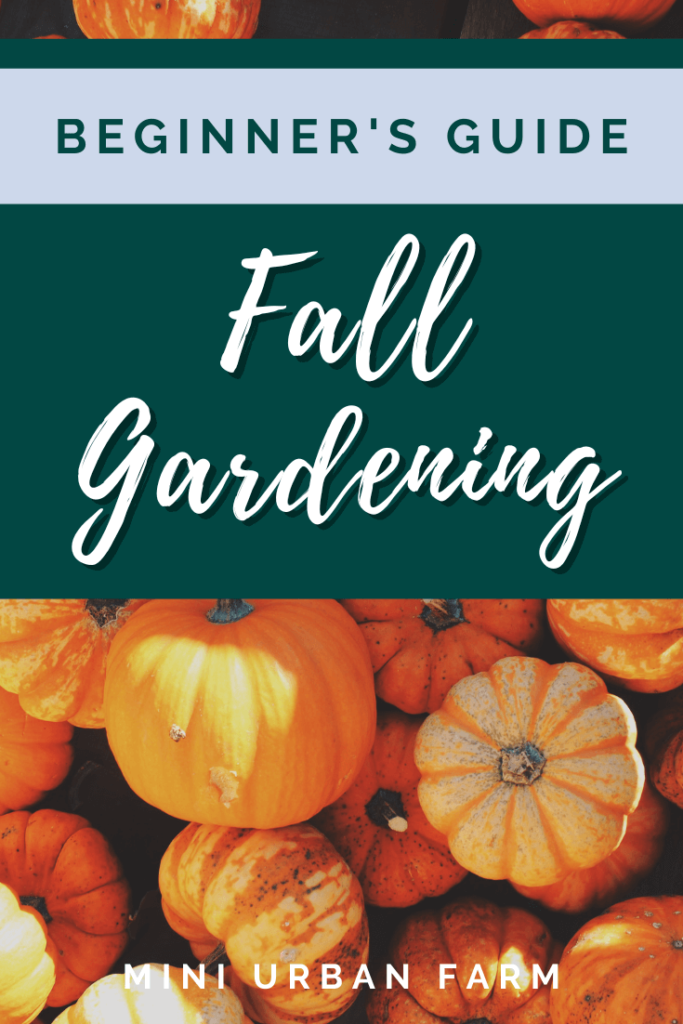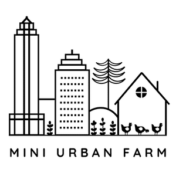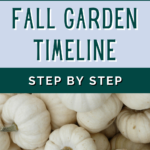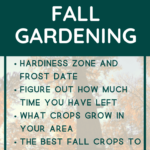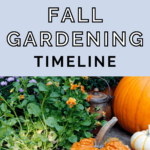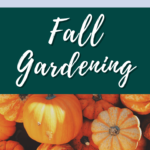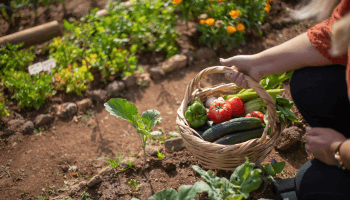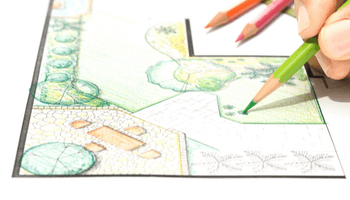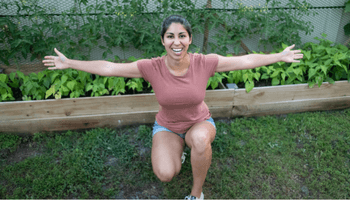Gardening in fall can be tricky because of the upcoming frost date that threatens to kill off most, if not all, of your vegetable plants. But I want to share with you my perfect fall gardening timeline so that you can get the most out of your vegetable garden no matter where you live. Plus, I’ve come up with some fall gardening tips on when to start fall vegetables!
When to Start Fall Vegetables:
- Find your hardiness zone and frost date
- Figure out how much time you have left
- What crops grow in your area
- The best fall crops to grow
- The perfect fall gardening timeline
- When is too early for fall gardening?
- Frost-tolerant vegetables
- How to protect crops from frost
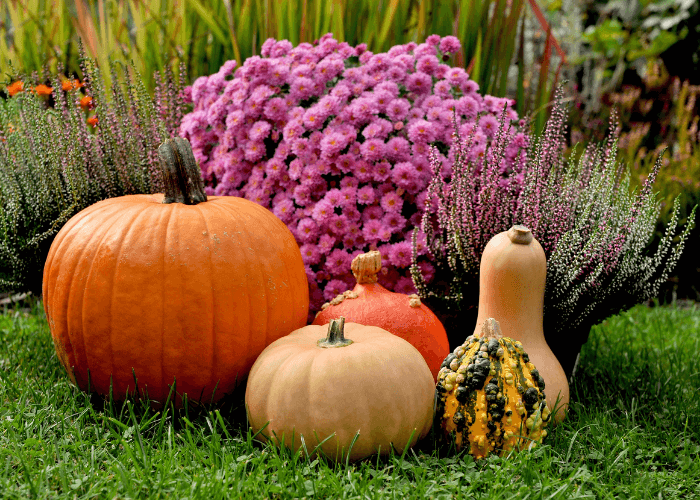
Disclosure: This post may contain affiliate links. If you purchase a product through one of our affiliate links we make a small commission from the sale at no extra cost to our readers.
When to Start Fall Vegetables (and the best fall gardening timeline)
I get tons of questions about growing food in fall or if you can even grow vegetables when summer is over. And the answer is yes, you totally can!
But things do get a little complicated when we start talking about frost dates, hardiness zones, and what kind of food you can grow.
So I’ve broken it down for you into any easy way to determine when to start fall vegetables!
1. Find Your Hardiness Zone and Frost Date
I know I sound like a broken record talking about how you need to know your hardiness zone all the time. But for fall gardening, you really do!
Not only will your hardiness zone determine how long you have left to grow vegetables, but it’ll tell you your first frost date. Or at least your estimated first frost date.
If you’re not familiar with what a hardiness zone is, it’s the standard by which gardeners and growers can determine which plants are most likely to thrive in a certain location. These are broken down by regions known as zones.
If you don’t know how to find your hardiness zone, it is super simple.
Just go online and search “hardiness zone + your zip code” and it’ll bring up your hardiness zone.
From there you’ll be able to find your estimated first frost date, and plan accordingly.
2. Figure Out How Much Time You Have Left
Once you have information about your hardness zone and first frost date, what you’re going to want to do is to calculate backward.
This will help you to determine the amount of time that you have left to continue gardening.
Although keep in mind that some vegetables are frost-hardy and won’t die off in a frost – more on that later!
So if, for example, my last frost date is December 15th, and we are in the middle of September, that gives me a window of about three months to continue gardening.
Now, if I only have three months and I’m starting to plant from seeds, what will grow? What plants will have enough time to grow from seed to harvest in that period of time?
This is where the fun starts!
Of course, if you’re running short on time to grow what you want, your best bet is to buy transplants from the garden center and plant them in your garden.
But if you’re starting from seed, you’re going to want to grow things that grow in the time you have left!
If I have three months before fall, growing something that takes six months from seed to harvest just won’t work.
Which means I will focus on things that will grow within that three months. For example, bush beans are going to be about 55 or 60 days to maturity – perfect!
Do this for each crop you want to grow and that will give you a good idea of what your fall garden will look like.
3. Consider What Crops grow In your area
You’re going to want to consider what things will actually grow in fall, and I have two examples: radishes and okra.
Number one, radishes.
Now, radishes are very quick to germinate and they are a cool season crop. They’ll probably not do very well in the heat of summer down in Florida, where we live.
But in the fall they will do just fine!
Now, okra on the other hand, loves the heat and will do especially well when it’s 90 degrees outside. But it’ll probably not do so well when it is in the 40s and 50s.
So okra is a no-go for my zone for fall.
The main thing that I want to point out here is that you will need to do some research depending on your zone.
My zone, 9b, central Florida will be able to grow different things than zone 5b, southern Maine.
Which is, obviously, because the temperatures are very different in those two locations.
So do some research on what grows will in your area for fall – you won’t regret it!
Psst…want to fast track your garden? Get access to my FREE gardening resource library and start maximizing your garden today!
4. The Best Fall Crops to grow
Now, not too contradict everything I just said, but…
There are certain types of vegetables that do better in the fall overall.
Of course, always check if it grows well in your zone first!
But generally speaking, things like salad greens and root crops will be the best bet for fall gardening.
To break it down, salad greens grow very fast. You can go from seed to harvest in just under a month with most salad greens.
Which is the perfect turnaround time for a very short fall gardening season if you’re gardening in those upper zones where it gets colder faster.
And you’re also going to want to focus on some root crops because these do really well when the temperatures drop. Think beets, carrots, and radishes.
They grow underground, which makes them an excellent choice when the temperature starts to get a little bit colder.
And the same thing with brassicas. They don’t do well in hot weather but are perfect in cooler temperatures. Think things like cauliflower, broccoli, and brussel sprouts
Use these three categories as a jumping off point and experiment from there!
5. The Perfect Fall Gardening Timeline
As far as a fall gardening timeline, it would be impossible for me to give you a timeline with actual dates on it because I don’t know where you live.
I also don’t know when you’re reading this post so what I’ll give you is a way to calculate a timeline that works for you.
Germinating your seeds
This is the first thing that you’re going to want to do for fall gardening. Generally somewhere between August-September, depending on where you live.
Now, this will not take very long and can be done in one day. But of course, you might want to wait a bit longer to start certain crops, so keep that in mind too!
However, allowing for the germination time, which varies by vegetable, could be anywhere from a few days to a week.
Plus, this can vary depending on if you’re starting indoors or direct sowing your seeds.
Allowing seedlings to be big enough for transplanting
I always get excited when I see the first leaves popping up through the soil!
But of you’re starting seeds ahead of time (aka not direct sowing) then you’ll need to give them some time before transplanting them into their final home.
This can be anywhere from a week to several weeks. But I generally like to wait at least a few weeks until they’re 4-6 inches tall.
This will not only give them the best defense against pests, but you’ll be able to pick the strongest seedlings to transplant.
Growing in the garden
So this is where the actual magic happens!
This will be the bulk of the fall gardening timeline since you’ll be waiting for those crops to grow.
Now, if you’re talking about salad greens, those will probably already have run their course in a month.
But if you’re talking about carrots on the other hand, they will need some time to do their thing – generally 2-3 months.
Harvesting
So if you’re planting carrots, the harvesting period will likely be pretty short.
They finish growing, you rip them up out of the soil, and voila – you’re done!
But, if you’re growing salad greens you’ll be able to harvest them for a longer period of time. Because many varieties of salad greens can actually be grown as cut and come again vegetables! (Check out more cut and come again veggies here!)
So don’t forget to allow some time to actually enjoy a longer harvest period!
When Is It Too Early for Fall Gardening?
If you are super anxious and don’t want to wait (which happens to me sometimes) then you might be asking yourself if it’s too early to plant your fall garden.
Generally, this is not a concern. You can plant your vegetables and then wait your time and put them in the garden. However, you are going to want to consider two things
One – If your vegetables are cold-season crops and you start them too early. Meaning you started them sometime in summer, and the temperature has not cooled down enough by the time that they’re ready to go in the ground.
If you’ve planted carrots and they’re starting to come up and germinate but it’s still 90 degrees outside, that’s probably not going to go too well.
You want to time it appropriately so that your fall crops get fall weather.
Two – Do you have enough space in your garden for your seedlings?
If you have a whole bunch of fall weather seedlings to transplant, you don’t want to have them ready and not have space in your garden.
In that situation you’re going to either have to keep them in your greenhouse for extra time. Or rip things out of your garden to make room.
Neither of those options are ideal.
Frost-Tolerant Vegetables
When it comes to the best fall crops, these are my recommendations which usually do well in fall weather. So when you’re considering when to plant fall vegetables, keep these at the top of your mind!
Brassicas — things like broccoli, cauliflower, and brussels sprouts.
I’m growing brussels sprouts and broccoli this season, but they will take a little bit more time to mature. You want to ensure that you’re starting them early, or that you have the time to grow them.
Plus, these are some of my favorite things to grow because you can use both the leaves and the vegetable!
Salad greens— things like lettuce, spinach, arugula, mustard greens swiss chard, and kale are all very fall-worthy. They tolerate some frost and grow really fast so absolutely perfect for fall growing!
Root crops— things like beets, radishes, and carrots because they grow really well in cooler weathers. Plus, most varieties of radishes can be harvested in less than a month!
How To Protect Crops From Frost
If you are growing things and you’ve gone well past your frost date, you’re not alone, it definitely happens to me too.
I grow things significantly past my frost date just to experiment and see if they will grow, and most of the time they do.
But, if there is a frost, how do you prevent your crops from dying? I do this in three different ways:
1) Bring Your Plants Indoors
Any crops that are in my raised garden beds will just have to stay outside. I don’t dig them up to bring them indoors.
But those that I have in containers definitely go inside when it gets too cold out.
Right now I have some chaya, mint, a whole bunch of snake plants, and some aloe plants, which I bring inside where they will be much better off without the cold temperatures.
2) Mulch Your Crops
Another thing you you’re going to want to do to protect your crops from frost is mulch. This keeps in the humidity and prevents your soil from drying out, especially in cold weather.
Mulching is great no matter what time of year it is, but to prevent frost, this is one of the best things that you can do.
You can either use live mulch by intercropping with other plants to make sure the soil is covered.
Or you can use actual mulch to protect your crops from frost.
But either way, mulch will definitely help your plants survive a frost!
3) Cover Your Crops With A Blanket
Yes, that’s right— take a blanket and cover your vegetables.
That will prevent the wind and the temperatures from affecting your crops. I have done this in years past, and it has always worked out.
Just make sure you have a trellis or cage of some sort to rest the blanket on so that it doesn’t take down your plant.
Hopefully you got a lot out of this post on when to plant fall vegetables! And for more gardening resources, get access to our free gardening resource library! It will help you fast track your garden and it only takes 5 seconds!
PIN When to Start Fall Vegetables
